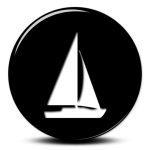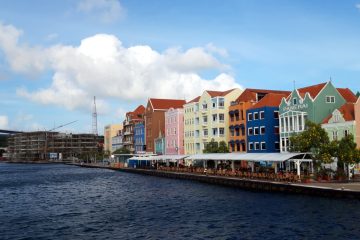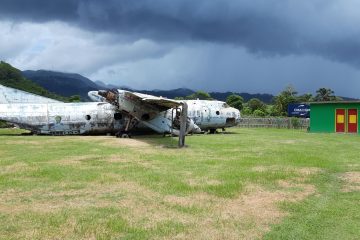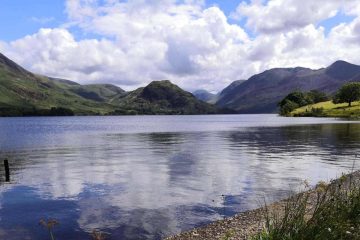We travelled under motor from Prickly Bay back to the buoy in front of Grand Anse Beach, then one last time shopping and a pizza in the marina with our Italian friends.
Back on the “Maya” we clean up and then the dinghy is stowed aft on the davits.
Early in the morning we plan to go to the fuelling station to refuel again with diesel and get water. But when we get there, a catamaran is already waiting. The problem is that the fuel station has run out of diesel and the tanker with more is not yet there!
We are to come back in an hour so back out to the buoy. In total we go back and forth three times before we can finally fill up our tanks at 1530. We weren’t the only ones waiting and it was a bit of a scramble to get on the fuel jetty for our “turn”. Luckily the guy in charge of the fuel station had it all under control and only allowed people to fuel up in the order they had been waiting.
At 1600 we finally get underway.
The weather forecast shows rather calm weather for the next 2 days and unfortunately very little wind. After that there will be a front with thunderstorms and high waves up to 2m. So we have to hurry, because we want to arrive at daylight in Curacao.
Unbeknown to us this is the storm front of the still forming hurricane “Julia”.
At the start we have beautiful weather and it is very relaxed and we have a last wistful look back at green Grenada.
During the night we take turns every two hours and turn off the AIS transmitter (we can still “listen” and see other traffic) and also the navigation lights so that we are an invisible boat and do not draw further attention to ourselves. There have been several cases of piracy along the coast of Venezuela and the theory is that the pirates track the yachts with AIS.
On the 2nd day there is so little wind that we set our cruising chute and then glide along. Early in the morning 6 big Atlantic dolphins accompany us and swim and dance around our bow. Great! I think I will never get tired of watching these intelligent animals.
Later in the afternoon we are joined by two exhausted Swifts – we often get one of these. Later still a Brown Boobie takes up temporary residency to hunt fish using the “arch” as a convenient look out. It was fun watching him lean left and right to match the rolling of the boat.
In the night come the first violent squalls with BF 8 and meter-high waves then we have to reef the genoa and wait. It rains heavily and again and again lightning flashes and thunder rolls around the sky above us. It becomes uncomfortable but fortunately not too cold to sit outside.
Ten minutes later it is usually calm again, but then it all repeats. We can track the squalls on the radar and it is helpful to know where they are and if they will hit us.
During the day the squalls can be identified by heavy, low cloud then rapidly advancing “whitecap” waves followed quickly a wall of fog/mist which is in fact the rain.
At night they are heralded by vivid flashes of lightning in quick succession, sometimes illuminating the advancing “whitecap” waves, before the rain hits in torrents.
We spend most of the time under motor as the wind rises to F8 and then just as quickly drops to F2. We both wished to be there at last. Visibility is dwindling and even the next morning we still see no land.
During the night we switch the AIS transmitter and our navigation lights back on as several ships are nearby. It’s worth the risk and anyway the pirates probably don’t come out in the bad weather!!
We have one scare during the night when a bright flashing light appears directly in front of us. A frantic check on the chart identifies this as the low lying island reefs of Barlovento and Sotavento. Collectively known as “Islas las Aves” or “Bird Islands”. A hasty change of course takes us out of the danger, but there could have been an extra wreck there otherwise! Another time when closer observation of the chart would have been advised.
Finally Bonaire hazily appears through the rain and fog and we continue on to pass Klein Curacao still in the rain and with lots of wind. This is very flat island with sandbanks and a lighthouse. It looks deserted and not very inviting.
Finally there are only 12 miles to go and so around 1800 we creep along the twisty shallow channel and into “Spanish water” and try to anchor.
It is crowded in the anchorage because many boats have sought refuge here. After 5 frustrating anchor attempts we give up. Our anchor does not want to hold and we try our luck in the mangrove bay “Fuik Baai” south of Spanish water.
On the first attempt here the anchor bites in and holds fast. Despite 35 – 40 knots of wind we lie here safely with two other boats and can finally calm down and sleep in peace.
It is wonderful the next morning we awake and hear the birds singing – it is totally relaxed here.
Here on Curacao everything is very regulated. You are only allowed to anchor for 24 hours and after that you need an anchor licence. We contact our German friends, Achim and Solvey, in the Seru Boca Marina and ask if there is still room for us. We are lucky we get the last place and decide to stay here for 4 weeks because it will be cheaper! Two weeks cost almost as much as 4 weeks.
Happily we enter the marina in the morning. After this trip we are no longer sure whether we really want to go into the Pacific. It is quite exhausting to be only two on the boat and always ready to act in any situation. On our Atlantic crossing John’s two sons were with us which made things easier and also helped a lot during the night shifts.
We will see how our journey continues, especially with the Worlds political events with the Ukraine war.



